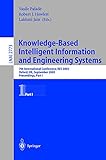Knowledge-Based Intelligent Information and Engineering Systems [electronic resource] : 7th INternational Conference, KES 2003, Oxford, UK, September 2003. Proceedings, Part I. / edited by Vasile Palade, Robert J. Howlett, Lakhmi Jain.
Material type: TextSeries: Lecture Notes in Computer Science ; 2773Publisher: Berlin, Heidelberg : Springer Berlin Heidelberg : Imprint: Springer, 2003Description: CII, 1476 p. online resourceContent type: text Media type: computer Carrier type: online resourceISBN: 9783540452249Subject(s): Computer science | Computer Communication Networks | Information storage and retrieval systems | Artificial intelligence | Management information systems | Computer Science | Artificial Intelligence (incl. Robotics) | Computer Communication Networks | Information Storage and Retrieval | Information Systems Applications (incl. Internet) | User Interfaces and Human Computer Interaction | Business Information SystemsAdditional physical formats: Printed edition:: No titleDDC classification: 006.3 LOC classification: Q334-342TJ210.2-211.495Online resources: Click here to access online
TextSeries: Lecture Notes in Computer Science ; 2773Publisher: Berlin, Heidelberg : Springer Berlin Heidelberg : Imprint: Springer, 2003Description: CII, 1476 p. online resourceContent type: text Media type: computer Carrier type: online resourceISBN: 9783540452249Subject(s): Computer science | Computer Communication Networks | Information storage and retrieval systems | Artificial intelligence | Management information systems | Computer Science | Artificial Intelligence (incl. Robotics) | Computer Communication Networks | Information Storage and Retrieval | Information Systems Applications (incl. Internet) | User Interfaces and Human Computer Interaction | Business Information SystemsAdditional physical formats: Printed edition:: No titleDDC classification: 006.3 LOC classification: Q334-342TJ210.2-211.495Online resources: Click here to access online  E-BOOKS
E-BOOKS
| Current library | Home library | Call number | Materials specified | URL | Status | Date due | Barcode |
|---|---|---|---|---|---|---|---|
| IMSc Library | IMSc Library | Link to resource | Available | EBK5258 |
Keynote Lectures -- General Session Papers -- Invited Sessions Papers.
2.1 Text Summarization “Text summarization is the process of distilling the most important information from a source (or sources) to produce an abridged version for a particular user (or users) and task (or tasks)” [3]. Basic and classical articles in text summarization appear in “Advances in automatic text summarization” [3]. A literature survey on information extraction and text summarization is given by Zechner [7]. In general, the process of automatic text summarization is divided into three stages: (1) analysis of the given text, (2) summarization of the text, (3) presentation of the summary in a suitable output form. Titles, abstracts and keywords are the most common summaries in Academic papers. Usually, the title, the abstract and the keywords are the first, second, and third parts of an Academic paper, respectively. The title usually describes the main issue discussed in the study and the abstract presents the reader a short description of the background, the study and its results. A keyword is either a single word (unigram), e.g.: ‘learning', or a collocation, which means a group of two or more words, representing an important concept, e.g.: ‘machine learning', ‘natural language processing'. Retrieving collocations from text was examined by Smadja [5] and automatic extraction of collocations was examined by Kita et al. [1].


There are no comments on this title.